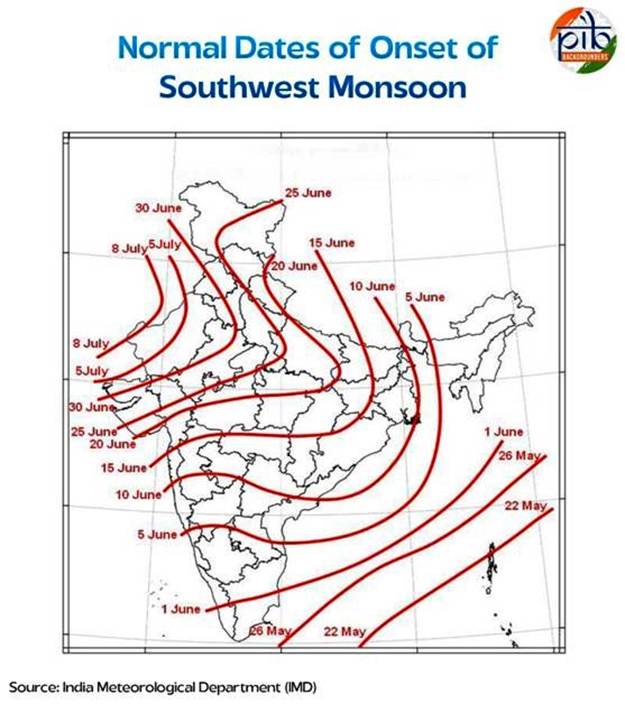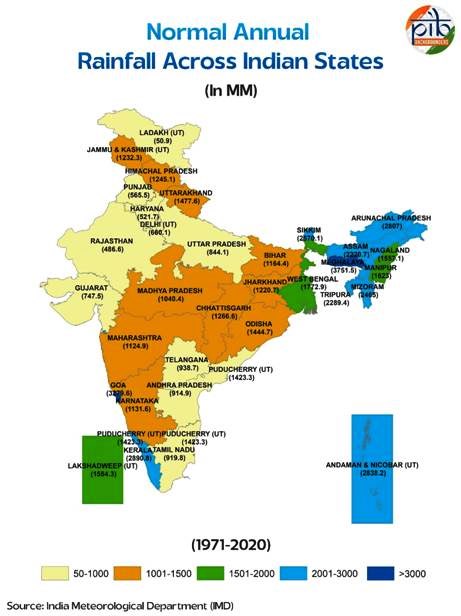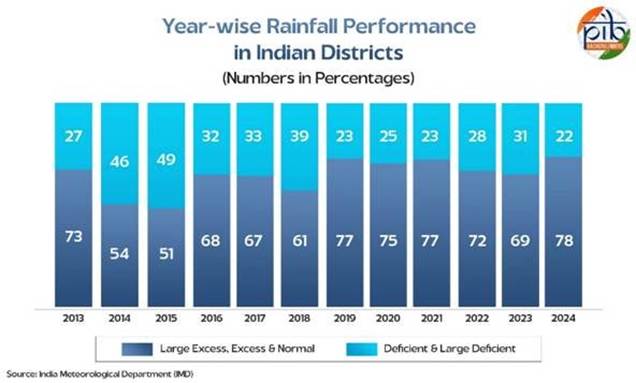Content :
- The Indian Monsoon: Nature’s Pulse and Nation’s Lifeline
- Nationwide Financial Inclusion Saturation Campaign sees a Significant Progress
The Indian Monsoon: Nature’s Pulse and Nation’s Lifeline
What is the Indian Monsoon?
- Derived from Arabic “Mausim“, meaning season.
- Seasonal reversal of winds due to differential heating of land and sea.
- Summer: Low pressure over land → Moist air from sea → Rainfall.
- Winter: High pressure over land → Dry offshore winds → Retreating monsoon.
Relevance : GS 1(Geography )
Types of Monsoon
- Southwest Monsoon (June–Sept)
- Brings 75% of India’s total rainfall.
- Vital for agriculture (esp. rice, cotton, sugarcane).
- Two branches: Arabian Sea & Bay of Bengal.
- Orographic rainfall prominent in Western Ghats & NE India.

- Northeast Monsoon (Oct–Dec)
- Retreating monsoon; winds from land to sea.
- Key for Tamil Nadu and SE coast (rain-shadow regions).
- Moisture gained over Bay of Bengal → Rains in south India.
Key Climatic Drivers
- Inter-Tropical Convergence Zone (ITCZ)
- Shifts northwards in summer → Triggers SW monsoon.
- Shifts south in winter → Causes NE monsoon.
- Forms monsoon trough → Responsible for cloud bursts and active spells.
- El Niño
- Warming of Pacific waters → Weak monsoon → Drought risk.
- 7 out of 16 El Niño years post-1950 showed below-normal rainfall.
- La Niña
- Cooling of Pacific waters → Stronger monsoon → Flood risks.
- Helps rain-fed farming but may trigger crop damage in excess.

Distribution & Variability of Rainfall
- Annual average rainfall: ~125 cm, with wide regional variation.
- >400 cm/year in Western Ghats & NE Hills (e.g., Mawsynram).
- <60 cm/year in western Rajasthan, Ladakh, and rain-shadow areas.
- Monsoon variability:
- Sub-seasonal: Active-break cycles.
- Interannual: Linked to ENSO.
- Decadal/Centennial: Observed long-term shifts.

Economic Significance
- 64% of Indians depend on agriculture.
- 45% of farmland is rainfed → Highly vulnerable.
- Good monsoon → GDP growth, rural demand, low inflation.
- Poor monsoon → Crop failure, inflation, distress migration.
Recent Monsoon Trends (2021–2024)
- IMD’s forecasts were accurate (within ±5% of LPA).
- 2024 rainfall: 934.8 mm (108% of LPA) – well distributed.
- 78% districts received normal to excess rainfall.
- Monthly trend (2024):
- June: 89% of LPA
- July: 109%
- August: 115%
- September: 112%
Climate Change & Monsoon
- Shift in rainfall geography:
- ↓ Kerala, NE & East-Central India
- ↑ Rajasthan, Maharashtra, North Karnataka
- Extreme Rain Events ↑ by 75% (1950–2015).
- Dry Spells ↑ by 27% (1981–2011 vs. 1951–1980).
- July rainfall declining, September gaining.
- 50% of monsoon rain now occurs in just 20–30 hours.
Role of IMD (India Meteorological Department)
- Established: 1875; under Ministry of Earth Sciences.
- Key roles:
- Seasonal forecasts (April & June updates).
- District-wise rainfall tracking.
- Cyclone early warning & disaster management.
Achievements
- 100% forecast accuracy (2021–24).
- Cyclone death toll: ↓ from 10,000 (1999) to zero (2020–24).
- Radar network ↑ from 15 (2014) → 39 (2023).
- Technological innovations:
- HRRR & EWRF models.
- Mausamgram portal launched in Jan 2024.
Mission Mausam (Launched: Sept 2024)
- Goal: Make India weather-ready & climate-smart.
- Merged with PRITHVI’s ACROSS scheme.
- Nine verticals:
- OBSERVE_All, DEVELOP, IMPACT, FRONTIER, ATCOMP, DECIDE, Weather_MOD, LEAD, NEAT.
- Focus areas:
- Extreme weather prediction, AI/ML integration, public-private partnerships.
Lightning Strikes: A Rising Concern
- One strike can carry up to 1 billion volts.
- Heat > 35,000°F – hotter than the Sun’s surface.
- ↑ frequency in Gujarat, Rajasthan, Punjab; no longer limited to NE India.
- IITM & NRSC data confirm trend shift.
Conclusion
- Monsoon = economic engine + ecological rhythm + cultural soul.
- Forecasting advances, policy readiness, and scientific missions like Mission Mausam enhance resilience.
- But climate variability demands constant vigilance, innovation, and adaptation.
Nationwide Financial Inclusion Saturation Campaign sees a Significant Progress
Campaign Overview
- Launched by: Department of Financial Services (DFS), Ministry of Finance
- Duration: 1st July – 30th September 2025 (3 months)
- Goal: Achieve saturation-level coverage of financial inclusion schemes across 2.7 lakh Gram Panchayats (GPs) & Urban Local Bodies (ULBs)
- Focus Schemes:
- PM Jan Dhan Yojana (PMJDY)
- PM Jeevan Jyoti Bima Yojana (PMJJBY)
- PM Suraksha Bima Yojana (PMSBY)
- Atal Pension Yojana (APY)
Relevance : GS 3(Banking ) , GS 2(Governance)
Progress So Far (As of 15 July 2025)
- Camps organized: 43,447 across districts
- Progress data compiled for: 31,305 camps
- Objective: Boost enrolment, update KYC/nomination, improve financial literacy
Key Achievements
- Banking Access
- New PMJDY Accounts opened: 1,39,291
- KYC Re-verified:
- PMJDY Accounts: 96,383
- Other Savings Accounts: 1,01,778
- Nomination Updates:
- PMJDY: 66,494
- Other Accounts: 63,489
- Social Security Enrolments
- PMJJBY: 1,83,225 new enrolments
- PMSBY: 2,88,714
- Atal Pension Yojana (APY): 67,668
- Claims Settled (PMJJBY + PMSBY): 1,665
Financial Literacy Drives
- Topics Covered:
- Digital fraud awareness
- Access to unclaimed deposits
- Grievance redressal mechanisms
Strategic Importance
- Aims to eliminate financial exclusion at the last mile.
- Empowers marginalized & rural populations via access to:
- Savings & insurance products
- Pension benefits
- Affordable credit and digital banking
- Reinforces SDG Goal 1 (No Poverty) and Goal 10 (Reduced Inequalities).
Broader Vision
- Builds upon India’s Financial Inclusion architecture since 2014.
- Complements Digital India, Jan Dhan-Aadhaar-Mobile (JAM) Trinity, and Social Security for All.
- Supports inclusive growth by integrating the unbanked, uninsured, and unpensioned into the formal financial system.



